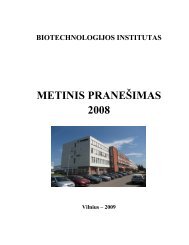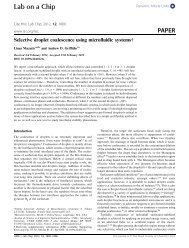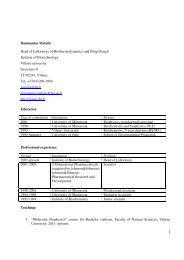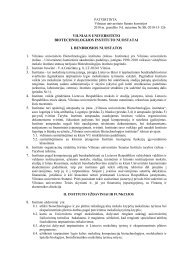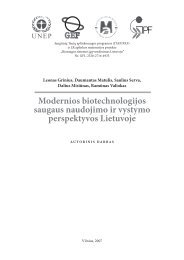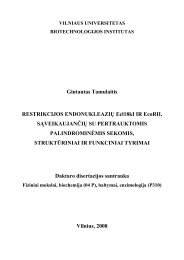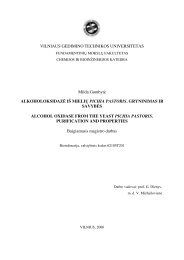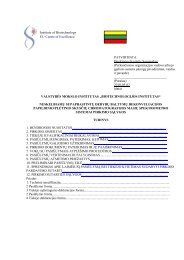Report 2008-2010
Report 2008-2010
Report 2008-2010
You also want an ePaper? Increase the reach of your titles
YUMPU automatically turns print PDFs into web optimized ePapers that Google loves.
COMA has been implemented as a standalone software package,<br />
making it suitable for large–scale studies. However, the use of standalone<br />
tools requires a certain level of expertise and substantial computer<br />
resources. Therefore, to make this method accessible for larger<br />
biological community, we have also developed a freely accessible web<br />
server (http://www.ibt.lt/bioinformatics/software/coma/). The server<br />
features a simple and intuitive user interface for setting up homology<br />
search jobs. The homology search is done by comparing query-based<br />
sequence profile against the selected profile database (at present<br />
SCOP, PDB and PFAM). The server output gives a concise information<br />
regarding structure, function and other relevant information for the reported<br />
hits. Hits are linked to original databases (PDB, SCOP or PFAM)<br />
and to the search results within the collection of PubMed articles using<br />
annotation of hits as keywords. If the search was performed against<br />
PDB or SCOP, the server provides a possibility to generate a 3D model<br />
of the query sequence based on the corresponding alignment.<br />
We believe that the COMA method will be useful for researchers in<br />
uncovering interesting novel links in the proteome universe.<br />
Identification of new homologs of PD-(D/E)XK nucleases by combination<br />
of Support Vector Machines and sequence profile-profile<br />
alignments<br />
PD-(D/E)XK nucleases comprise a large and extremely diverse group<br />
of proteins that are involved in various processes of nucleic acid metabolism.<br />
As it happens, the name of this large group of nucleases derives<br />
from the highly conserved ‘PD’ (in many cases only ‘D’) and<br />
‘(D/E)XK’ (‘X’ denotes the non-conserved position) active site motifs.<br />
Typically, different PD-(D/E)XK families share little or no recognizable<br />
sequence similarity. Although they all have a common structurally<br />
conserved core, the latter is often elaborated with large non-conserved<br />
peripheral elements. This makes it hard to recognize the similarity between<br />
PD-(D/E)XK domains not only by sequence comparison but<br />
sometimes even by structure comparison. Therefore, we considered<br />
to develop a new method specifically tailored for the detection of new<br />
PD (D/E)XK homologs. To make use of all the available structural and<br />
functional information of PD (D/E)XK domains, we developed a<br />
method that uses combination of a supervised machine learning<br />
method, Support Vector Machines (SVMs) and alignments obtained<br />
with HHsearch, a sensitive profile-profile homology search method.<br />
Using our newly developed method we were able to detect several<br />
new families in the PFAM database and assign a number of restriction<br />
endonucleases to the PD-(D/E)XK type. To make the method accessible<br />
for broader biological community we implemented it as a user-friendly<br />
web server accessible at: http://www.ibt.lt/bioinformatics/software/pdexk/.<br />
Development and testing of comparative (template-based) modeling<br />
methods<br />
Over the years we have been continuously working on the improvement<br />
of comparative (template-based) modeling methodology. In<br />
computational biology it is important to do regular “reality checks” to<br />
find out where your methods stand in relation to others. Additional<br />
motivation was to test our new homology detection method, COMA.<br />
Therefore, in <strong>2008</strong> we took part in a world-wide experiment on protein<br />
structure prediction known as CASP (Critical Assessment of Structure<br />
Prediction). Our team, named IBT_LT (Institute of Biotechnology,<br />
Lithuania), together with over 150 other predictor groups around the<br />
world tried to compute the closest possible 3D shapes of more than<br />
50 proteins provided by the organizers.<br />
IBT_LT team at the CASP8 meeting in Sardinia<br />
The structures of these proteins had been unknown at the time of the<br />
experiment and were released to the public only after predictions were<br />
collected. This setting ensured that the testing of protein structure<br />
prediction methods was done in the most objective way. After the results<br />
of the CASP8 experiment were assessed by independent experts,<br />
it turned out that the results obtained by our team (IBT_LT) were<br />
ranked first (Fig. 3) in the most representative, template-based, protein<br />
structure prediction category (see also Cozzetto et al. (2009) Proteins:<br />
77 Suppl 9:18-28). The detailed comparison of the performance by different<br />
groups in the CASP8 experiment is available at the UC Davis<br />
Prediction Center website (http://predictioncenter.org/casp8/groups_analysis.cgi).<br />
Our methods used in CASP8 and the obtained results have<br />
been reported in the invited article published as part of the special<br />
issue of Proteins: Structure, Function, and Bioinformatics [2].<br />
Figure 2. CASP8 protein structure prediction results for the top 50 expert<br />
groups. Results of our group (IBT_LT) are indicated with a red arrow.<br />
35 th anniversary<br />
50



